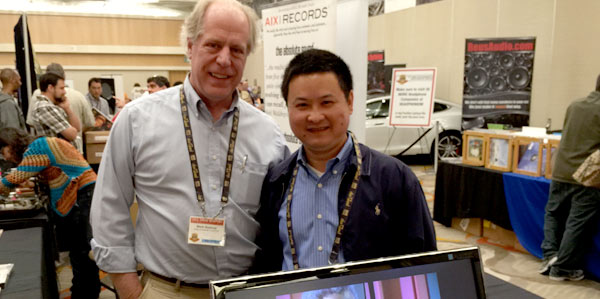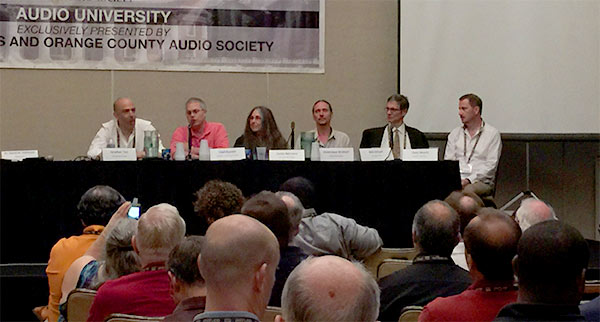Newport Beach Show : Day 2
I got to the Irvine Hotel a little late yesterday. As I leaving my office, I locked and closed the door with my keys inside. Yep, a real bonehead move. After trying to MacGyver my way in with a credit card for about 15 minutes, I was forced to call my very loving and patient wife and ask if she would be so kind as to come to the studio and rescue me. She and Charlie showed up about 30 minutes later and I was finally on my way.
Saturday’s are usually the busiest days at audio trade shows and I’m sure that traffic was up on Saturday. The whole place was buzzing with audiophile enthusiasts both young and old. I chatted with a lot of familiar customers and made my pitch to those that had not yet heard high-resolution music.
It was a real treat to see Jason from Oppo Digital come by the AIX booth. I looked up and there he was taking pictures of the table equipped with an Oppo BDP-103, a Benchmark DAC2 HGC, and two pairs of Oppo PM-1 headphones. I’m very anxious to get my hands on their latest device, the HA-2 Portable Headphone Amplifier and DAC. Jason told me that it’s been very well received by the audio press and customers. I’m going to do a review as soon as I can get my hands on one. Knowing the build quality and reputation of the company, I’m sure I won’t be disappointed.
Figure – 1 – Jason Liao from Oppo Digital stopped by the AIX tables.
In fact, as Jason and I were standing there chatting a few customers gathered and were admiring the Oppo BDP-103 and recommending to a third gentleman that had not yet taken the plunge into Blu-ray. When I introduced Jason to them there were very enthusiastic and expressed great satisfaction with the players and company. Their designs, build quality, customer service, value, and attention to audio fidelity stands above most companies producing similar products.
I did mange to get away from the Marketplace room a couple of times. I stopped in at the Meridian demo room looking for Robert Stuart but learned he was at lunch. I did catch up with him right after the show at an event hosted by Scott Wilkinson of AVS Forum. Robert and I are going to have lunch today. I’m looking forward to learning more about his plans for MQA. While I was at the Meridian room, I spoke with a Meridian representative that I’ve known for many years. I asked how he describes the process and whether the hyperbole found in many of the reviews were accurate…we agreed that the MQA technology is not a fidelity enhancement process…it is a codec that identifies the specific hardware used in a digital conversion and preserves all of the fidelity in a smaller stream…that is backwards compatible. Seems like the overblown audiophile reviewer-speak doesn’t jive with the facts.
Finally, I poked my head in the Audio University room just after 4 pm to catch a little of the “DSD and Analog: The Great Convergence” panel. Dr. David Robinson moderated a crowded panel that included Bob Attiyeh, Cookie Marenco, Chad Kassem, Thom Moore from Five/Four Productions, Jonathan Tinn, and Dominique Brulhart of Merging Technologies.
The tag line from the show’s website says, “This panel discussion on DSD will focus on the similarities between Single, Double, and Quad DSD and analog recording.” An obvious effort is to tie DSD and analog recording…like that’s a good thing. When I entered the room, Bob told the full house that Dual and Quad DSD recording comes “extremely close” to analog recording. Then Chad and Cookie introduced themselves and continued promoting the myth of DSD.
Unfortunately, there wasn’t a panel focused on the merits of PCM populated with people like Bob Stuart, Jonathan Reichbach of Amarra, John Siau from Benchmark, and Al Schmidt. Maybe I’ll make the pitch next year to the organizers for a panel called, “PCM: The Ultimate High-Resolution Digital Format…Bettering Analog.”
Got to run…the last day looms.




Singe, double, and quad DSD and Analog recording have something huge in common. In today’s market their promoters are spreading BS to make large profits for both the hardware and software manufactures. Look out guys, the MQA marketing wing is looking to knock you off that “sounds like analog” hill fast.
Dispite what your friend said Mark, I don’t see them writing any “Manufacturers Comments” letters back to the reviewers saying “Oh no, we’re not a sound enhancement device, only a very good compression codec”. 🙂
I had a great lunch with the co-inventor of MQA and friend Robert Stuart yesterday. I think I’ve got the straight scoop on the technology and their plans. I don’t know if I’ll get the post written today, but stay tuned.
Off Topic, Sorry
When time allows could you do a blog explaining the details of why modern recordings are still being done at 48/24 when so much better is easily available. I was shocked the other day to read that even film sound is done the same way. Here I was foolishly believing my DTS-HD Master Audio blue ray movies were delivering me at least 96/24 7.1 or 192/24 5.1 sound. All this highly capable tech available and it’s just going to waste while we are being lied to that the capabilities is what we are receiving. 🙁
It is very hard to move glaciers like the music and film industries. I seriously doubt that they will be upgrading to high-resolution audio anytime soon. There are real challenges to working with 192 kHz or even 95…and they don’t hear any difference.
It just confuses the heck out of me how so many people can work so hard developing advanced technology’s like bluray, DTS-HD Master, Dolby Digital, etc. Then they rightly promote it’s capabilities to sell discs, (and motive seats).. But the guys back at the recording end waste all that and are allowed to turn it into a lie recording and editing in a much degraded manner.
The public never ends getting lied to and screwed. SAD
Exactly. The artists, engineers, producers, and labels need to up their game…but they are unlikely to do so. The attitude is..”who cares?”
The DSD fans treat DSD with religious fervor. The fact that it tends to roll off the top and a little at the bottom for that “analog sound” doesn’t matter to them. And quad DSD is an absolute joke designed for one purpose, and that is to charge even more money for a recording. It sounds no different than double DSD which in turn sounds remarkably like single DSD. If it mattered (and is doesn’t), Jared Sacks, whose recordings are spectacular, would use it. He uses single DSD.
Terrific idea !! wrt “PCM: The Ultimate High-Resolution Digital Format…Bettering Analog.”
How about creating a Studio Master Source logo with associated wording to state the format and resolution of the studio master source. Or perhaps, adapting the Hi-Res logo.
The word ‘True’ could also indicate that the transfer to another format had not taken place during the creation of the studio master source.
So, a DSD studio master source edited in PCM could not claim to be ‘True’.
Resulting examples could be:
LOGO
Source: True 96/24 PCM
LOGO
Source: True DSD128
LOGO
Source: DSD128
LOGO
Source: Analogue Tape
People who care will make informed choices about whether they want to buy upscaled, downscaled recordings or those reformatted from/to DSD or PCM.
People who don’t care won’t care….
Julian, thanks for your input. I’ve thought about this a great deal over the past couple years. And my experience with audiophiles, audio companies, website etc. has convinced me that we have to circumvent the DEG, CEA, JAS, NARAS, and the rest of them. Everyone with any sense is simply ignoring their meaningless and confusing definitions and logos. I’m going to make my case directing to the download sites, the manufacturers, and audio community. Maybe we can build a ground swell that will wash away the misleading mumbo jumbo that’s already out there and get some real information to consumers. Stay tuned.
T.R.U.E could be a good acronym to use.
True Resolution Unmolested Encoding or True Resolution Unmodified Encoding.